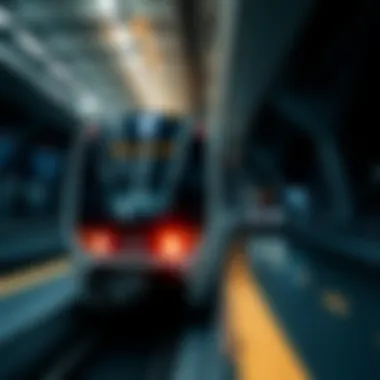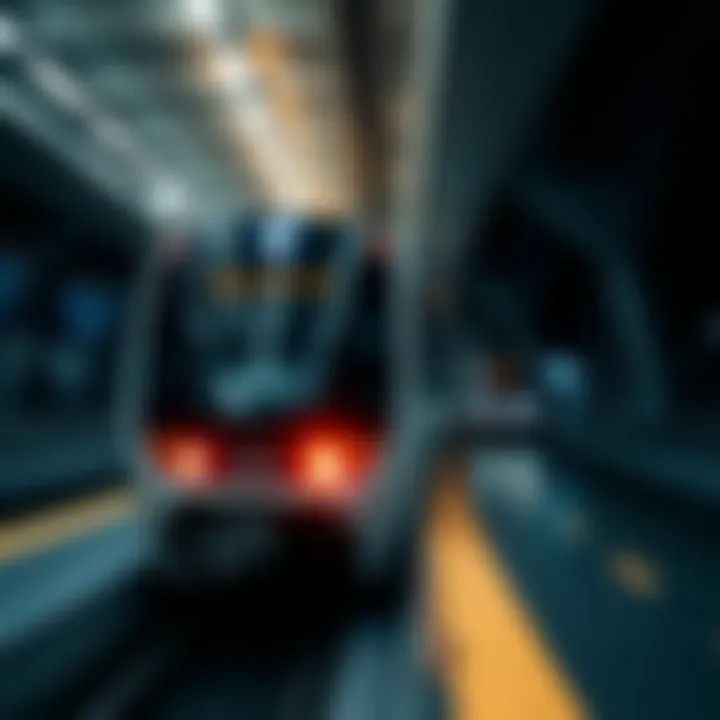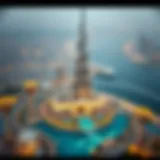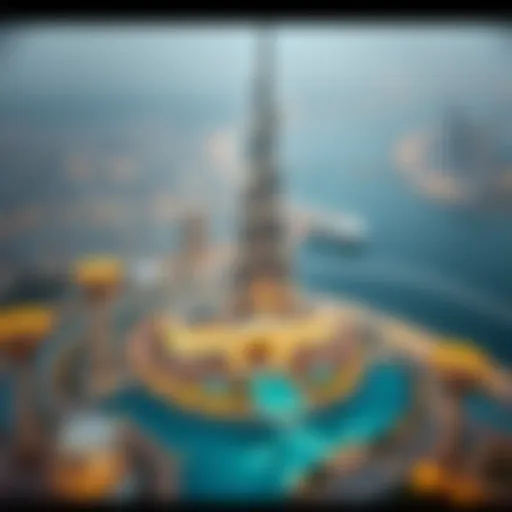Chronology and Impact of the Dubai Metro System


Intro
The Dubai Metro System is more than a mere transportation network; it represents a carefully orchestrated response to the growing needs of a bustling metropolis. Established in a city characterized by rapid development, the metro initiated its journey in 2009, marking a turning point in how residents and visitors navigate this vibrant urban landscape. The project not only aimed to alleviate traffic congestion but also aspired to transform the economic fabric and social structure of Dubai. Through its strategic placement and expansion, the metro system has undoubtedly left an indelible mark, prompting discussions around real estate development and urban planning.
With its seamless connectivity between business hubs, tourist attractions, and residential areas, the metro aids in reshaping how individuals perceive mobility. The infrastructure created as part of this project contributes significantly to the property market, introducing new dynamics and influencing investment potential. Understanding the significance of this system requires delving into various aspects—ranging from market insights regarding current trends and pricing, to investment strategies that potential buyers and investors may consider.
As the world watches Dubai evolve, the inception and expansion of the metro system have become pivotal focal points, reflecting both regional ambitions and the responsiveness of urban planning to community needs. In the subsequent sections, we will explore these dimensions in detail, offering a thorough examination that caters to various stakeholders, including investors, buyers, agents, developers, and expatriates.
Preamble to Dubai Metro
The Dubai Metro system stands as a testament to the rapid transformation and forward-thinking planning that characterizes Dubai's urban landscape. This introduction provides a contextual foundation for discussing the intricacies of the metro system which has become an indispensable asset for both locals and visitors alike, impacting mobility, infrastructure, and even economic dynamics across the Emirate.
Overview of Urban Transit Systems
Urban transit systems worldwide serve as lifelines, connecting neighborhoods to commercial districts, schools, and cultural hubs. They reduce traffic chaos, cut down on pollution, and most importantly, enhance the quality of life for city dwellers.
Dubai, a metropolis known for its ambition, mimics successful attributes found in cities like Tokyo and New York while weaving its unique fabric into the narrative of modern transportation. The user-friendly design of the Dubai Metro, with its state-of-the-art trains and stations, emphasizes efficiency. Here are few factors that highlight the significance of strong urban transit systems:
- Affordability: Public transit is often more economical than owning a personal vehicle, particularly in regions where fuel prices are high or parking is scarce.
- Accessibility: Well-designed systems allow easy access to those with mobility challenges, creating inclusive spaces.
- Reduced Environmental Impact: Public transport can contribute to lowered carbon emissions and reduced urban smog, making cities more livable.
Overall, the successful operation of a transit system like the Dubai Metro can greatly influence a city’s attractiveness for investment and tourism, echoing patterns seen in other major global centers.
Finding the Need for a Metro System in Dubai
As Dubai burgeoned into a hub of commerce and tourism, the challenges associated with urban sprawl became increasingly apparent. The streets, designed for a smaller populace, faced congestion and pollution, which in turn affected daily life. The pressing need for an efficient metro system emerged from these challenges, supported by several pivotal considerations:
- Population Growth: A 10% annual increase in population demanded a reliable transport solution.
- Tourism Surge: With millions flocking to the city each year, the flow of people necessitated a transport system that could manage high volumes without compromising comfort.
- Economic Diversification: As Dubai sought to diversify its economy away from oil dependence, enhancing infrastructure was integral to supporting increasing commercial activities and attracting foreign investments.
Timeline of the Dubai Metro Launch
The timeline surrounding the launch of the Dubai Metro is crucial for understanding its evolution and significance in the city’s urban transit landscape. This network did not arise overnight; rather, it resulted from comprehensive planning, considerable investment, and addressing persistent transport challenges. By mapping out this timeline, we unravel the layers of strategy and foresight that propelled Dubai towards this revolutionary transit system.
Initial Proposals and Planning Stages
In the mid-1990s, the rapid growth of Dubai’s population and vehicular traffic painted a pressing necessity for an effective public transport system. City planners and leaders commenced discussions on the development of a metro system to ease congestion and foster connectivity among various areas. Proposals emerged, highlighting the dire need for a sustainable transit option amidst burgeoning urban development. After several feasibility studies, the Government of Dubai, under the direction of Sheikh Mohammed bin Rashid Al Maktoum, formally greenlit the project in 2003.
The planning phase included engaging global engineering firms, with the hopes of finding innovative solutions while ensuring safety and efficiency. Many industry experts were involved, providing insights on system layout, station design, and overall feasibility. Their experiences from city-specific challenges worldwide brought forth ideas that resonated with local requirements, setting the groundwork for a trailblazing urban transport system.
Construction Phases and Challenges
Construction began in 2006, with various phases to tackle. Each phase came with its unique set of hurdles. For instance, engineers faced geological challenges due to the sandy terrain and high water table in certain areas. Additionally, the project demanded advanced technology to ensure its envisioned success, compelling contractors to think outside the box.
As the work progressed, schedules tightened, often placing immense pressure on workforce management and safety compliance. The integration of state-of-the-art systems, including automated train control and energy-efficient designs, prioritized innovation. In mid-2009, the first segment of the Red Line was completed, showcasing the ability to manage large-scale infrastructure projects efficiently.
Inauguration of the Dubai Metro
Finally, on September 9, 2009, a day marked within the city’s history, the Dubai Metro was inaugurated, with much fanfare surrounding the event. Not just any date, the 9th day of the 9th month in 2009 was a deliberate choice, symbolizing good fortune in numerology within the Arab culture.


"The inauguration of the Dubai Metro signified a turning point in public transportation for the region, showcasing Dubai’s ambitions on a global stage."
With the launch, the nuclear core of urban mobility in Dubai began to shift dramatically, serving as a model for other cities. Over 10,000 passengers utilized the system on its opening day, underlining its immediate importance and acceptance by residents and visitors alike. The event heralded the beginning of a new era in commuting for Dubai.
Expansion Milestones Post-Launch
Following the inauguration, Dubai Metro did not rest on its laurels. The government announced further expansions, reflecting the growing demand for efficient transit solutions in urban zones. Notably, the extension of the Red Line reached the UAE Exchange Station in 2010, while the Green Line made its debut in 2011, connecting vital commercial and residential areas.
By 2015, additional stations and new phases were proposed to further enhance interconnectivity, solidifying the metro’s role in transforming the urban transportation milieu. Moreover, it became clear that the metro system not only addressed mobility but also provided the impetus for real estate development, sparking an economic revitalization around transit nodes.
The timeline of the Dubai Metro’s launch captures a journey driven by ambition, resilience, and vision. From proposals to the expansions that followed, it charts the course of a transformative transit infrastructure that profoundly affected Dubai's urban landscape.
Impact on Urban Mobility
The arrival of the Dubai Metro was a game-changer for urban mobility within the bustling city. As the city’s population surged, so did the need for a reliable and efficient public transport system. The metro doesn’t just serve as a means of commute; it symbolizes a shift in how residents and visitors experience and navigate through Dubai. The metro, with its sleek design and modern technology, has transformed the way people move around the city.
Reduction in Traffic Congestion
One of the most apparent benefits the Metro has brought to Dubai is its significant role in reducing traffic congestion. Prior to its opening, many drivers faced daily headaches during peak hours, stuck in bumper-to-bumper traffic. The metro has effectively provided an alternative. With an impressive capacity, it can transport thousands of passengers each hour, alleviating the pressure on roadways. According to reports, traffic congestion has seen a notable decrease since the Metro’s launch, resulting in a better air quality and less stress for commuters.
- Emissions Reduction: Less cars on the road contributing to lower CO2 levels.
- Time Savings: Daily commuters can save substantial time on their journeys.
"The Metro has transformed how we travel; it’s like breathing fresh air after being underwater for so long."
Facilitating Travel for Residents and Tourists
The Dubai Metro has also simplified travel for residents and tourists alike. Visitors can effortlessly access major attractions such as the Burj Khalifa and the Mall of the Emirates, enhancing their overall experience in the city. The ease of navigating public transport has made Dubai more accessible, encouraging tourism and allowing residents to explore their city without the hassle of parking or traffic. Moreover, it fosters a sense of independence for those who may not own a vehicle or prefer not to drive.
- Connections to Key Areas: Stops near financial districts, leisure spots, and more.
- Affordable Travel: A cost-effective alternative compared to taxis or rideshares.
Integration with Other Transport Modes
A crucial aspect of the Dubai Metro’s impact on urban mobility is its integration with other modes of transport. The system was designed to work in tandem with buses, taxis, and even water taxis, creating a seamless network for users. Passengers can easily switch from the metro to a bus or catch a taxi at various stations, allowing for flexible travel options. This kind of multimodal transport system ensures that no part of the city is hard to reach.
- Unified Payment Systems: One card can be used for various modes of transport, enhancing user convenience.
- Strategically Located Stations: Designed to connect with major transport hubs and residential areas.
Real Estate Trends Related to the Metro
The advent of the Dubai Metro System has led to noticeable shifts in the real estate landscape across the city. Not only does the metro provide a reliable means of transport, it also greatly influences property values and residential choices. Real estate dynamics shift based on how accessible the area is to key locations via the metro network, making it an essential topic for anyone interested in the Dubai property market.
Property Values Along Metro Lines
When the metro was first launched, it was like flipping a switch. Properties located near metro stations saw immediate upticks in value. This is not just a passing trend; it's a well-documented phenomenon where proximity to mass transit infrastructure positively correlates with property appreciation.
Consider areas like Dubai Marina or the Burj Khalifa, where housing prices tend to reflect the ease of access to the metro. Investors and buyers are keenly aware that properties with nearby stations often command higher rents and resale values, creating a win-win scenario for both landlords and tenants. This advantage is particularly appealing for expatriates looking for rental properties, as they increasingly favor locations that facilitate a hassle-free commute.
Factors influencing property values near the metro include:


- Convenience: Residents can easily travel to work or leisure spots without a car, leading to higher demand for these properties.
- Development Opportunities: New businesses tend to crop up around metro stations, creating vibrant communities that make nearby properties more valuable.
- Sustainability Trends: Increasingly, buyers value properties that are eco-friendly and support sustainable living, which metro systems promote by reducing road traffic.
Shifts in Neighborhood Dynamics
The impact of the Dubai Metro on neighborhood dynamics can’t be understated. As stations have opened, they’ve acted like beacons for development, drawing in residents and businesses alike. The once quiet suburbs are now buzzing with activity.
For instance, neighborhoods that were previously perceived as remote have transformed into bustling areas ripe for commercial growth. Community engagement has surged as newcomers flood in, bringing with them fresh ideas and diverse cultures.
Moreover, the metro system has made previously inaccessible areas attractive for both residential and commercial investors, leading to gentrification in certain neighborhoods. This shift could mean:
- Increased Amenities: With new businesses stepping up to meet the demand, residents enjoy improved amenities—from cafes to grocery stores.
- Rise in Sociability: As more people settle in, community events and gatherings become the norm, fostering a sense of belonging.
- Challenges of Gentrification: While there are benefits, it’s important to note that not everyone may benefit equally. Long-time residents might feel displaced as property values rise and taxes follow suit, creating a complex picture of neighborhood evolution.
"The transformation brought about by the Dubai Metro is a testament to the interconnectedness of transit infrastructure and real estate markets."
In summary, the Dubai Metro is not just a mode of transport but a critical factor in reshaping the real estate landscape of the city. Investors, agents, and expatriates alike should keep a keen eye on these trends, as they can pave the way for lucrative opportunities within the ever-evolving property market.
Economic Considerations of the Metro
The Dubai Metro stands as a keystone in the city’s approach to urban development and economic growth. This modern transit system not only reshapes the framework of daily commutes but becomes a conduit for economic invigorations. Investing in such public infrastructure pays dividends that extend beyond mere transportation; it stirs local economies, stimulates businesses, and contributes to a broader economic vision. The implications of the Dubai Metro on the local economy and employment opportunities are substantial.
Boosting Local Businesses
One can't dismiss the palpable surge in commerce that stems from the mere presence of metro stations. When the Dubai Metro rolled into operation, it altered the economic landscape for many local enterprises. Restaurants, shops, and service providers popped up, particularly in areas surrounding station entrances. These businesses experienced a bump in foot traffic, quite literally putting them on the map of consumer routes.
For instance, a quaint café located near the Burjuman station has witnessed consistent growth in daily customers, thanks to metro patrons seeking a quick bite or a caffeine fix before heading to work. This increase in business is not an isolated incident. A multitude of retailers located close to metro stations reported similar patterns, leading to not only survival but flourishing amidst competitive pressures. It is clear that the metro isn't just about moving people; it’s about connecting them to the commercial opportunities that the city offers.
Moreover, the enhanced accessibility reduces logistical hurdles, benefiting suppliers and small business owners alike. When public transport is efficient, employees are more likely to commute without the worry of congested traffic and unreliable transport alternatives. Thus, the economic ripple effect extends from immediate businesses to bind the entire local economy tighter together.
Influence on Job Creation
When a new transit system arises, so do new job opportunities, and the Dubai Metro is no exception. Beyond the immediate construction jobs necessitated by its development phase, the operation of the metro system generates ongoing employment across various sectors. This includes everything from train operations and maintenance to station management and customer service.
Consider the myriad of roles created directly linked to the metro's existence. Ticket sales representatives, maintenance crews, and security personnel are just a glimpse into the workforce catered by the metro. Indirectly, the metro fuels job growth in surrounding areas as businesses expand or new ones emerge to meet the demand fueled by the influx of metro riders.
Additionally, the availability of reliable and rapid public transport invites a diverse workforce. Young professionals, expatriates, and even tourists have greater access to job opportunities throughout the city—a development crucial for maintaining a dynamic labor market. The ripple effects reach even into the realms of skill development, where individuals can secure employment opportunities that previously seemed out of reach, enabling them to elevate their economic standing.
"A solid metro system is not merely a convenience; it is a significant contributor to the job market and a catalyst for local commerce."
Thus, the impact of the Dubai Metro on economic considerations is profound. It isn't just about transportation; it's about creating a thriving ecosystem that uplifts communities, fosters growth, and prepares the city for a prosperous future.
Social Implications of the Dubai Metro
The advent of the Dubai Metro represents a major shift, not only in transport but as a catalyst for social change. The metro system has dramatically reshaped not just how residents navigate the city, but also how they interact, connect, and integrate into the fabric of urban life.
The significance of the metro extends beyond mere transportation efficiency. With stations sprouting in various neighborhoods, the metro fosters a sense of community and accessibility for a wide range of demographic groups within Dubai. Such inclusivity is key, making it possible for diverse communities, including expatriates and local residents, to enjoy easier access to key areas of the city.
Enhancing Accessibility for Diverse Communities


Accessibility is a significant part of what makes any urban planning initiative successful. The Dubai Metro plays a pivotal role in enhancing mobility for various communities, especially those that may have previously been underserved by public transport.
- Connecting People: The metro bridges gaps between affluent areas and those that are further removed from central business districts. Residents in suburbs or less-populated areas like Al Qusais or Al Nahda can easily reach downtown locations, which promotes socio-economic interaction.
- Economic Opportunities: For many in the workforce, especially laborers and service industry employees, commuting to work can be a logistical nightmare. With an efficient and affordable transport system like the Dubai Metro, individuals have the chance to broaden their job prospects without the burden of lengthy travel times.
- Cultural Exchange: Accessibility also encourages a vibrant exchange of cultures. With the ease of travel, residents from different backgrounds can converge at various stations, facilitating an understanding and appreciation of diverse cultures. This fosters a sense of community and cohesion that might not have been possible before.
"Public transport is the lifeline for urban communities. The Dubai Metro symbolizes not just movement, but connection among people from all walks of life."
Environmental Sustainability Achievements
The significance of the Dubai Metro also resonates through its contributions toward environmental sustainability. As urban centers face heightened concerns regarding pollution and climate change, the metro system serves as a model for sustainable transport solutions.
- Reduced Carbon Footprint: Compared to private vehicles, metro systems like Dubai's considerably lower greenhouse gas emissions. The reliance on electric trains reduces the need for fossil fuel consumption, promoting a greener approach to urban mobility.
- Encouragement of Public Transport Usage: By providing an efficient alternative to cars, the Dubai Metro encourages more residents to opt for public transport over driving. This shift helps reduce traffic congestion and leads to fewer cars on the road, which has an obvious positive impact on air quality.
- Sustainable Urban Growth: The integration of the metro into the urban planning strategy signals a shift towards sustainable development. By aligning transportation with urban expansion, Dubai sets an example in creating environments that prioritize both human and ecological health.
In suite, the social implications of the Dubai Metro are profound and multi-faceted. Not only does it enhance accessibility for a variety of communities, but it also sets a benchmark for environmentally sustainable transit systems globally. The continued development and emphasis on public transportation promise substantial social and environmental benefits in the heart of this vibrant city.
Future Developments in the Dubai Metro Network
Looking ahead, the future developments in the Dubai Metro network are undeniably significant. As a backbone of urban transport, these enhancements aim not only to better accommodate growing populations but also to integrate more sustainable practices within the city’s infrastructure. With the UAE’s vision for 2040 firmly in place, future expansions are set to transform the current metro system into a more extensive, efficient, and technologically advanced transit option for residents and visitors alike.
Planned Extensions and Upgrades
The planned extensions of the Dubai Metro are an ambitious response to the increasing demand for comprehensive urban transit options. Among the most anticipated is the expansion of the Red Line towards the Dubai World Central airport, a site that is expected to see a significant increase in activity due to Expo 2020 (which was held in 2021 due to global circumstances). This extension isn’t just a luxury; it’s necessity as it links key areas of commerce and tourism directly to the heart of the city.
Furthermore, upgrades to existing lines are on the horizon, targeting enhancements such as improved station accessibility and real-time information systems. The goal here is clear: reduce wait times and enhance the overall commuter experience. With plans for new train models that promise greater speed and comfort, the focus shifts towards efficient and enjoyable travel.
Another angle to note is the strategic integration of feeder bus services that may accompany these extensions. Offering reliable first- and last-mile access to metro stations ensures that whole neighborhoods gain easier access to rapid transit, making the benefits of the metro reach every corner of Dubai.
Technological Innovations in Transit
While the infrastructure grows, so too does the technology that supports it. The future of the Dubai Metro will likely embrace cutting-edge technologies designed to streamline operations and elevate passenger experiences. Concepts such as driverless trains and artificial intelligence for predictive maintenance are gradually becoming the norm in modern transit systems, and Dubai is no exception to this trend.
A further highlight includes the implementation of integrated smart ticketing solutions. This innovation allows for seamless fare payment across various modes of transportation, ultimately making journeys smooth from start to finish. Imagine hopping onto a metro train, then easily transferring to a tram, all with a single contactless card. This kind of user-friendly approach is essential in an era where convenience reigns supreme.
Moreover, the use of data analytics will play a significant role in enhancing service efficiency. Gathering real-time data on passenger flows will enable system operators to adapt schedules dynamically, ensuring that trains are available when and where they’re needed the most.
"The future of the Dubai Metro doesn't just lie in physical expansions but in becoming a smart, adaptive transit ecosystem that enhances urban living."
As these developments unfold, investors, buyers, agents, and expatriates will find new opportunities linked to real estate along these upcoming transit routes. The focal point remains a shared vision of a city that thrives on mobility, accessibility, and sustainability.
For further insights about urban transit systems and their impact, resources like Britannica or Wikipedia provide a wealth of information.
Closure
The conclusion serves as a vital juncture in our narrative about the Dubai Metro System, encapsulating the myriad insights gleaned from its evolution and significance. By recounting the history, impact, and future potential of the metro, we shed light on why it stands as a cornerstone in Dubai's infrastructure and urban planning strategies.
Recap of Key Insights
In revisiting this topic, a few prominent insights emerge as crucial:
- Transformative Urban Mobility: The Dubai Metro has revolutionized how residents and tourists navigate the city, providing efficient, reliable, and sustainable transport options.
- Real Estate Impact: Proximity to metro stations has significantly influenced property values, shaping a trend where commuters prioritize accessibility, driving development along the metro's corridors.
- Economic Boost: The metro has catalyzed local business growth, attracting further investment and contributing to job creation within sectors directly and indirectly related to public transport.
- Social Accessibility: Enhanced connectivity has enriched social interactions among diverse communities, fostering inclusivity across socio-economic groups.
Final Thoughts on the Metro's Role in Dubai's Future
As we look towards the horizon, the Dubai Metro’s future developments hint at soaring potential. With ongoing expansions and upgrades, including the implementation of cutting-edge transit technologies, the metro is poised to not only accommodate an increasing population but also to reinforce Dubai's reputation as a global hub for commerce and tourism.
Ongoing investments in sustainability measures also indicate a commitment to reducing the urban carbon footprint. The integration of smart technologies, such as automated systems and real-time data analytics, further positions the metro as a model for modern urban transit systems.







